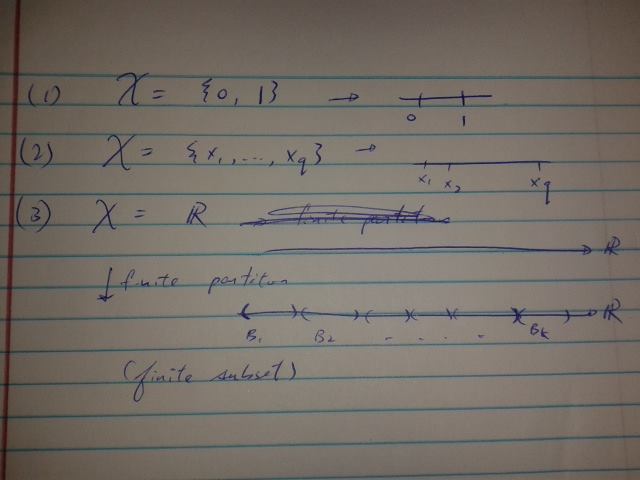29 Sep, 2015
Foundations for DP
Notes
- Lecture Notes 1 (read by next lecture)
- Stochastic Processes (read by next lecture)
Finite-dimensional vs. Infinite-dimensional Models
| Dimensions | Finite | Infinite |
|---|---|---|
| Model | Parametric | BNP |
| Sample spcae | $ \{ \theta = (\mu,\sigma) \} $ | $\{ f(y;\theta): y \in \mathbb R \}$ |
Note that $\theta$ has infinite dimensions in the BNP model.
Model
- Parametric:
- Semi-parametric:
where $x_i’\beta$ is the mean, median, etc.
- $\beta \sim $ parametric prior
- $F \sim $ prior for $F$ such that mean / median = $x_i’\beta$
- So, one possibility: \(\begin{array}{rclcl} x_i'\beta &|& F &\sim& F \\\\ & & F &\sim& DP(F_0,\alpha) \\\\ \end{array}\)
| Parametric | Classical nonparametric | BNP | |
|---|---|---|---|
| $y_i = x_i’\beta + \epsilon_i$ | No parametric assumptions | Prior on $F$ | |
| Only assumption: E[$\epsilon_i$] = 0 | |||
| OLS, minimize $\sum(y_i-x_i’\beta)^2$ | |||
| Get uncertainty using bootstrap, etc. |
Guassian Process (GP)
A Gaussian process is a statistical distribution $\mathbf X_t$, $t \in T$, for which any finite linear combination of samples has a joint Gaussian distribution. More accurately, any linear functional applied to the sample function Xt will give a normally distributed result. Notation-wise, one can write $X \sim \text{GP}(m,K)$, meaning the random function $\mathbf X$ is distributed as a GP with mean function $m$ and covariance function $K$. When the input vector $t$ is two- or multi-dimensional, a Gaussian process might be also known as a Gaussian random field.
Alternatively, a process[definition needed] is Gaussian if and only if for every finite set of indices $t_1,\ldots,t_k$ in the index set $T$ \({\mathbf{X}}_{t_1, \ldots, t_k} = (\mathbf{X}_{t_1}, \ldots, \mathbf{X}_{t_k})\) is a multivariate Gaussian random variable.
Study the Gaussian Process.
Foundations for the DP
Random distribution (like a random variable, but the distribution is a distribution) $Q$ on a sample space $\mathcal X$ (say $\mathcal X = \mathbb R$)
- $\mathcal X = \{0,1\}$
- $\mathcal X = \{x_1,x_2,…,x_q\}$
- $\mathcal X = \mathbb R$
- Need a finite partition, subsets
